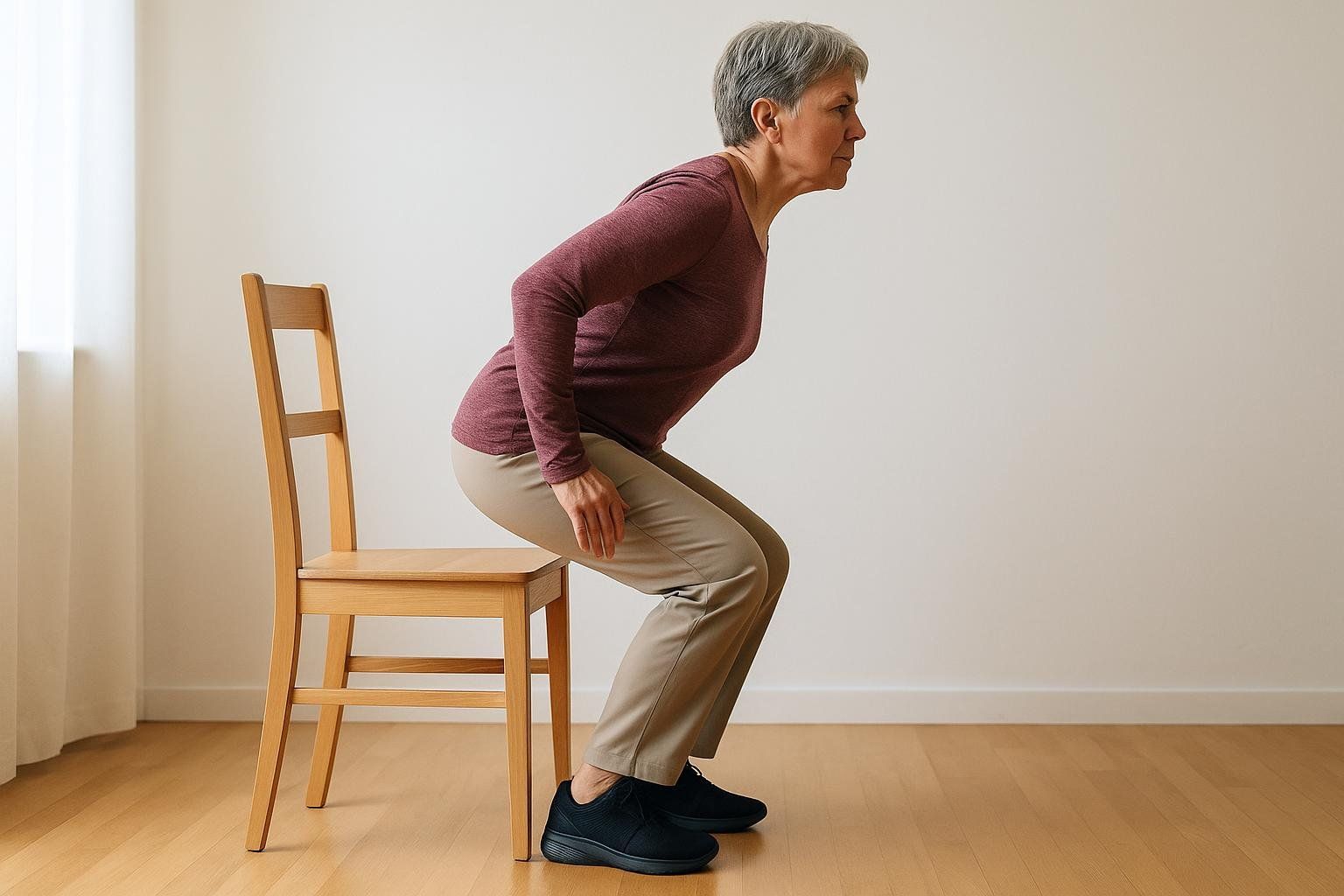Sarcopenia: The Complete Guide to Age-Related Muscle Loss

Sarcopenia: The Complete Guide to Age-Related Muscle Loss
Sarcopenia is a progressive loss of muscle mass, strength, and function that naturally occurs with aging. After age 30, adults begin experiencing a gradual loss of muscle mass at a rate of approximately 3-5% per decade. This process picks up between ages 65 and 80. This progressive muscle decline affects an estimated 5-13% of adults aged 60 and older, increasing to between 11% and 50% for those over 80. While often dismissed as inevitable aging, this condition can be significantly slowed and its effects substantially mitigated with proper intervention—helping you maintain strength, independence, and quality of life as you age.
What Is Sarcopenia? Understanding the Silent Epidemic
Sarcopenia, derived from the Greek words "sarx" (flesh) and "penia" (loss), is officially defined as a progressive and generalized loss of skeletal muscle mass, strength, and function that occurs with aging, as described by the Cleveland Clinic. In 2016, the condition gained official recognition when the CDC classified it as a disease with its own ICD-10 code (M62.84), marking a crucial step forward in diagnosis and treatment.
In sarcopenia, both the number and size of muscle fibers decrease significantly. This dual mechanism involves fewer fibers overall combined with shrinking of remaining fibers. It leads to the comprehensive muscle atrophy that characterizes this condition and distinguishes it from normal age-related changes.

The Three Pillars of Sarcopenia
The framework from the European Working Group on Sarcopenia in Older People recognizes sarcopenia through three key components:
- Reduced muscle mass (the foundational issue)
- Decreased muscle strength (functional impact)
- Impaired physical performance (real-world consequences)
According to the revised European consensus on sarcopenia diagnosis (EWGSOP2), sarcopenia severity is classified as:
- Probable sarcopenia: Low muscle strength
- Confirmed sarcopenia: Low muscle strength AND low muscle quantity
- Severe sarcopenia: Low muscle strength, low muscle quantity, AND poor physical performance
Recognizing the Warning Signs: Sarcopenia Symptoms
Sarcopenia often masquerades as "normal aging," but certain red flags should prompt closer attention:
Physical Symptoms
- Muscle weakness: The hallmark symptom, often first noticed when struggling with previously manageable tasks
- Loss of stamina: Feeling tired more quickly during routine activities
- Slower walking speed: Taking longer to cover familiar distances
- Difficulty climbing stairs: Needing to use railings or pause for breath
- Poor balance: Increased unsteadiness, especially when standing from seated positions
- Frequent falls: Often the first sign that brings people to medical attention
- Visible muscle shrinkage: Particularly noticeable in arms and legs
Functional Impacts
- Struggling to rise from low chairs without using arms
- Difficulty lifting objects that were previously manageable (like grocery bags or grandchildren)
- Needing assistance with daily activities like opening jars or carrying items upstairs
- Reduced ability to recover quickly from minor illnesses or injuries
The Root Causes: Why Sarcopenia Develops
Understanding what drives sarcopenia is crucial for both prevention and treatment. The process involves a complex interplay of biological and lifestyle factors:
Age-Related Changes
Hormonal Decline: As we age, levels of anabolic hormones like testosterone, growth hormone, and IGF-1 naturally decrease. These hormones are essential for muscle protein synthesis—the process by which our bodies build and maintain muscle tissue.
Neurological Changes: Age-related neurodegeneration affects motor neurons and neuromuscular junctions, disrupting the communication between our nervous system and muscles. This leads to both strength loss and coordination problems.
Inflammatory Environment: Older adults often have elevated levels of inflammatory markers like CRP, TNF-alpha, and IL-6, which can contribute to muscle breakdown.
Lifestyle Factors
Physical Inactivity: Perhaps the most modifiable risk factor. Sedentary behavior accelerates muscle loss and is often the difference between healthy aging and rapid decline.

Nutritional Deficiencies: Inadequate protein intake is a major contributor. Many older adults don't consume enough high-quality protein to maintain muscle mass.
Medical Conditions
Several chronic diseases can accelerate sarcopenia development:
- COPD, heart failure, and kidney disease
- Diabetes and insulin resistance
- Cancer and HIV
- Rheumatoid arthritis
- Malnutrition
Sarcopenic Obesity: A Dual Threat
An increasingly common and particularly dangerous variant is sarcopenic obesity��—having both excess body fat and reduced muscle mass, often accompanied by high levels of visceral fat. Research shows that sarcopenic obesity is associated with particularly high 10-year mortality risk compared to either condition alone.
Modern Diagnosis: From Questionnaires to Advanced Imaging
Initial Screening: The SARC-F Questionnaire
Individuals can begin their sarcopenia assessment with the SARC-F questionnaire—a simple self-screening tool that evaluates five key areas:
- Strength: "How much difficulty do you have lifting and carrying 10 pounds?"
- Assistance with walking: "How much difficulty do you have walking across a room?"
- Rising from a chair: "How much difficulty do you have transferring from a chair or bed?"
- Climbing stairs: "How much difficulty do you have climbing a flight of 10 stairs?"
- Falls: "How many times have you fallen in the last year?"
Each question is scored from 0-2, with a total score of 4 or higher suggesting probable sarcopenia that warrants further evaluation.
Strength Testing: Measuring Functional Power
Handgrip Strength: The most widely used strength assessment, with cutoffs of <27 kg for men and <16 kg for women indicating concern.

Chair Stand Test: According to EWGSOP guidelines, taking more than 15 seconds to complete five rises from a chair suggests impaired lower body strength.
Physical Performance Assessments
Gait Speed: According to EWGSOP2 criteria, a walking speed slower than 0.8 meters per second indicates severe sarcopenia and significantly increased fall risk.
Short Physical Performance Battery (SPPB): A score of ≤8 indicates poor performance and high risk for adverse outcomes.
The Role of DEXA Scans in Sarcopenia Management
While questionnaires and functional tests provide valuable insights, DEXA (dual-energy X-ray absorptiometry) represents the gold standard for measuring muscle mass. This advanced imaging technique provides precise measurements of:
- Appendicular lean mass (ALM): The muscle mass in your arms and legs
- Total body composition: Including fat mass, lean mass, and bone density
- Regional analysis: Identifying specific areas of muscle loss
DEXA's advantages include exceptional accuracy, simplicity, availability, low cost, and minimal radiation exposure—making it increasingly central to sarcopenia diagnosis and monitoring. DEXA scanning provides valuable insight into muscle health by establishing baseline measurements, monitoring changes over time, identifying muscle loss before functional symptoms appear, and enabling treatment optimization based on objective data. Schedule your DEXA scan to get precise muscle mass measurements and begin tracking your sarcopenia risk.
Treatment and Prevention: Your Action Plan
Exercise: The Foundation of Sarcopenia Management
Please consult with a healthcare provider or certified physical therapist before beginning any new exercise program, especially if you have existing health conditions or concerns about your physical capabilities.
Resistance Training: The most critical intervention. Research consistently shows that progressive resistance training can improve muscle strength and reverse muscle loss.
Progressive resistance training means gradually increasing the challenge to your muscles over time—whether by adding more weight, performing more repetitions, or completing additional sets. This progressive overload is what stimulates muscle growth and strength gains. Here's what effective progressive resistance training looks like:
Beginner Program (New to Exercise)
Frequency: 2-3 sessions per week
Focus: Bodyweight and light weights
Key Exercises:
- Chair-assisted squats (2-3 sets of 10-15 repetitions)
- Wall push-ups (2-3 sets of 8-12 repetitions)
- Modified planks (2-3 sets of 15-30 second holds)
- Bicep curls with light weights (2-3 sets of 8-12 repetitions)
- Overhead presses with light weights (2-3 sets of 8-12 repetitions)
Balance and Stability:
- Single-leg stands while holding onto a chair for support (2-3 sets of 30-60 seconds each leg)
Intermediate Program (Some Experience)
Frequency: 3 sessions per week
Focus: Light to moderate weights
Lower Body:
- Weighted squats (3 sets of 10-15 repetitions)
- Lunges (3 sets of 10-15 repetitions)
- Step-ups onto a sturdy box or stair (3 sets of 10-12 repetitions each leg)
Upper Body:
- Dumbbell rows (3 sets of 8-12 repetitions)
- Overhead presses (3 sets of 8-12 repetitions)
- Resistance band exercises (2-3 sets of 12-15 repetitions)
Core & Stability:
- Planks (3 sets of 12-15 repetitions)
- Leg raises (3 sets of 12-15 repetitions)
- Bird-dog exercises (3 sets of 12-15 repetitions)

Advanced Program (Experienced)
Frequency: 3-4 sessions per week
Focus: Compound movements with moderate to heavy weights
Key Exercises:
- Barbell squats and variations (3-4 sets of 6-10 repetitions)
- Pull-ups (3-4 sets of 6-10 repetitions)
- Lat pulldowns (3-4 sets of 6-10 repetitions)
- Overhead press (3-4 sets of 6-10 repetitions)
- Bench press (3-4 sets of 6-10 repetitions)
- Romanian deadlifts (3-4 sets of 6-10 repetitions)
- Walking lunges with weights (3 sets of 10-12 repetitions each leg)
Nutrition: Fueling Muscle Maintenance and Growth
This is general nutritional information. Individual nutritional needs vary. Please consult with a healthcare provider or registered dietitian for personalized guidance.

Protein Requirements: The PROT-AGE study group recommends older adults consume 1.0-1.2 g protein per kilogram of body weight daily—significantly higher than the standard recommendation of 0.8 g/kg.
Protein Distribution: Aim for 20-35 grams of protein per meal to optimize muscle protein synthesis throughout the day.
High-Quality Protein Sources:
- Lean meats and poultry
- Fish and seafood
- Eggs and dairy products
- Legumes and beans
- Nuts and seeds
- Whey protein supplements (particularly effective for older adults)
Sample Daily Meal Plan for Sarcopenia Prevention
Breakfast (25g protein): Greek yogurt with nuts and berries, plus one egg
Lunch (30g protein): Grilled chicken salad with quinoa and beans
Snack (10g protein): Cottage cheese with fruit
Dinner (35g protein): Baked salmon with steamed vegetables and a high-protein side like quinoa or lentils
This sample plan provides approximately 100g of protein. Adjust portions to meet your individual daily target based on your body weight and activity level.
Living with Sarcopenia: Practical Daily Strategies
Home Environment Modifications

- Install grab bars in bathrooms and key locations
- Ensure adequate lighting throughout the home
- Remove tripping hazards like loose rugs
- Keep frequently used items at accessible heights
Exercise Integration Tips
- Start with short, frequent sessions (even 10 minutes counts)
- Focus on functional movements that mirror daily activities
- Use resistance bands for convenient home workouts
- Consider group classes for motivation and social connection
Nutrition Practical Tips
- Meal prep protein-rich foods in advance
- Keep healthy protein snacks readily available
- Consider protein supplements if struggling to meet targets through food alone
- Work with a registered dietitian for personalized planning
Your Next Steps: Taking Action Today
Sarcopenia may be common, but it's not inevitable. Whether you're concerned about prevention or already experiencing symptoms, taking action today can dramatically improve your trajectory.
Immediate Actions:
- Complete the SARC-F questionnaire honestly
- Assess your current protein intake against the recommended 1.0-1.2 g/kg daily target
- Begin a basic strength training routine
- Schedule a DEXA scan for baseline assessment
Long-term Strategy:
- Develop a consistent exercise routine focused on resistance training
- Optimize your nutrition with adequate protein intake
- Monitor your progress with regular DEXA scans
- Work with healthcare providers to address any underlying health issues
Conclusion: Your Path Forward
Sarcopenia represents one of the most significant yet modifiable aspects of aging. The evidence-based strategies outlined in this guide—progressive resistance training, optimized protein intake, and precision monitoring through DEXA scanning—provide a proven framework for maintaining and improving muscle health throughout life.
Taking action early makes all the difference. Whether you're 40 and planning ahead or 70 and noticing changes, the principles remain the same: challenge your muscles consistently, fuel them adequately, and track your progress objectively. Schedule your BodySpec DEXA scan today to establish your baseline measurements and begin your journey toward stronger, healthier aging.


